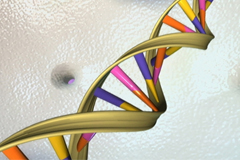News + Media
 |
Analysis + OpinionJuly 21, 2014Smallpox: the long goodbyeJeanne GuilleminBulletin of the Atomic ScientistsLast week, six vials of smallpox virus were discovered in a disused closet at the National Institutes of Health, where they had lain, forgotten and misplaced, for over 30 years. |
 |
In the NewsJuly 17, 2014Genetically engineering almost anythingTim De Chant and Eleanor NelsenNovaWhen it comes to genetic engineering, we’re amateurs. Sure, we’ve known about DNA’s structure for more than 60 years, we first sequenced every A, T, C, and G in our bodies more than a decade ago, and we’re becoming increasingly adept at modifying the genes of a growing number of organisms. But compared with what's coming next, all that will seem like child's play. |
 |
News@E40July 17, 2014In memoriam: JoAnn CarminAssociate Professor JoAnn Carmin passed away on July 15, 2014. Carmin had been on the faculty of MIT's Department of Urban Studies and Planning since 2003 and was the founding director of the Center's Program on Environmental Governance and Sustainability. "JoAnn was a great colleague, smart, savvy, and deeply committed to doing good in the world. She came to us with an idea for a new program, which she headed and made into a success—the Program on Environmental Governance and Sustainability. It was focused on student research, and I'm sure she made a huge difference in many students' lives," said John Tirman, executive director and principal research scientist at CIS. |
 |
In the NewsJuly 17, 20143 Qs: Kenneth Oye on genetic engineeringPeter DizikesMIT NewsKenneth Oye, an associate professor of political science and engineering systems who studies government regulation and directs MIT’s Program on Emerging Technologies, is lead author of an article in Science today making the case that the U.S. government, and international groups, need to adapt their procedures to enable more robust discussion and evaluation on genetic engineering. MIT News asked him to discuss the topic. |
 |
News ReleaseJuly 17, 2014New genome editing strategy for ecosystemsA cross-disciplinary team is calling for public discussion about a potential new way to solve longstanding global ecological problems by using an emerging technology called "gene drives." The advance could potentially lead to powerful new ways of combating malaria and other insect-borne diseases, controlling invasive species, and promoting sustainable agriculture. Kenneth Oye is author of the Science paper and director of the Center's Program on Emerging Technologies. MIT News Feature | Science Full Text |
 |
Analysis + OpinionJune 18, 2014The legacy of unlearned lessons, and the current crisis in IraqJohn TirmanWBUR: CognoscentiThe advances of the extremist group Islamic State of Iraq and Syria (ISIS) deep into the heart of Iraq from its base in Syria is an occasion for introspection in the United States. |
 |
Analysis + OpinionJune 16, 2014The case for doing nothing in IraqBarry PosenPoliticoWhenever there’s a crisis anywhere in the world, you can count on America’s pundit class to demand action—usually of the military variety. |
 |
Analysis + OpinionJune 16, 2014ISIS continues dramatic takeover of territory in IraqJim WalshWBUR: CognoscentiHere & Now's Jeremy Hobson talks to Jim Walsh, an expert in international security at MIT's Security Studies Program, about the developments in Iraq and Ukraine. |
 |
In the NewsJune 1, 2014Knowing the enemyAlec WorsnopWhat makes an insurgency effective and deadly? It is a question the U.S. has been posing with increasing urgency since 9/11, and it is a central research preoccupation of Alec Worsnop, a Ph.D. candidate in political science. |
 |
In the NewsMay 29, 2014From conflict, cooperationNicole Estvanik TaylorMIT SPECTRVMFor her recent book Alliance Formation in Civil Wars, political scientist, Fotini Christia interviewed Afghan warlords and mujahideen. Her “counterintuitive” finding was that alliances among warring factions were fluid, owing more to pragmatic power dynamics than to religious or ethnic identities. She discovered, however, that identity narratives were often retrofitted to justify shifts from foe to friend and back again. |

